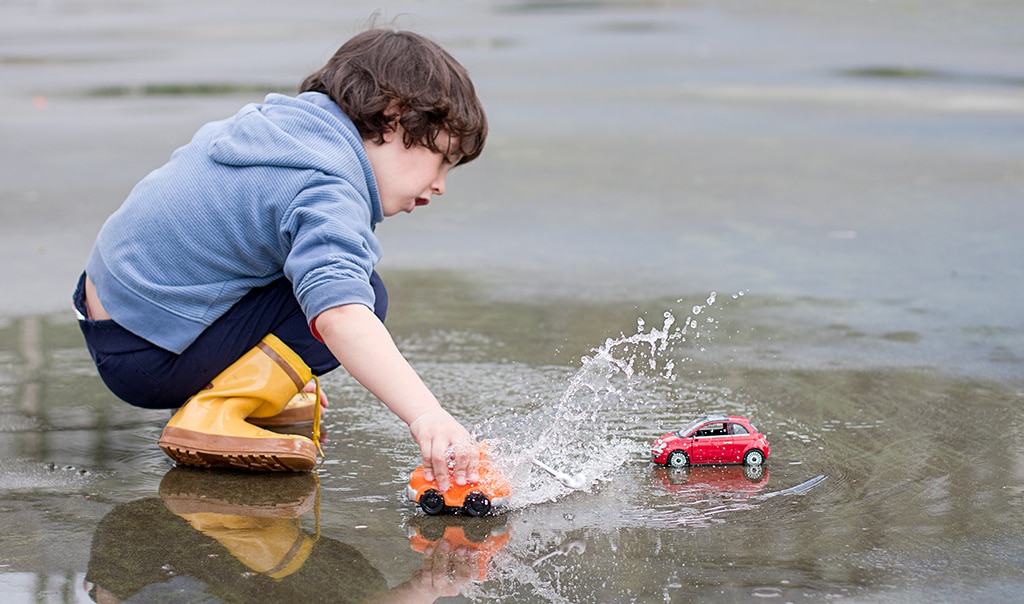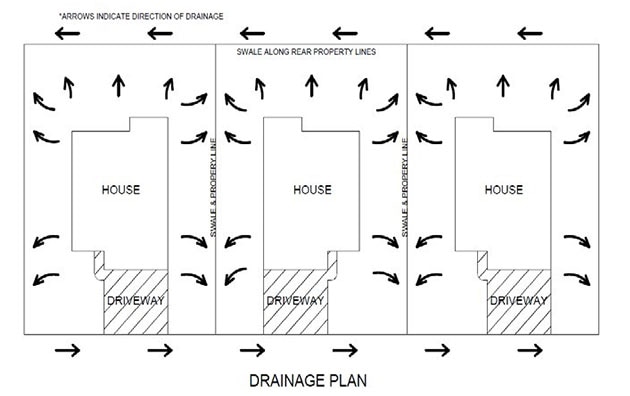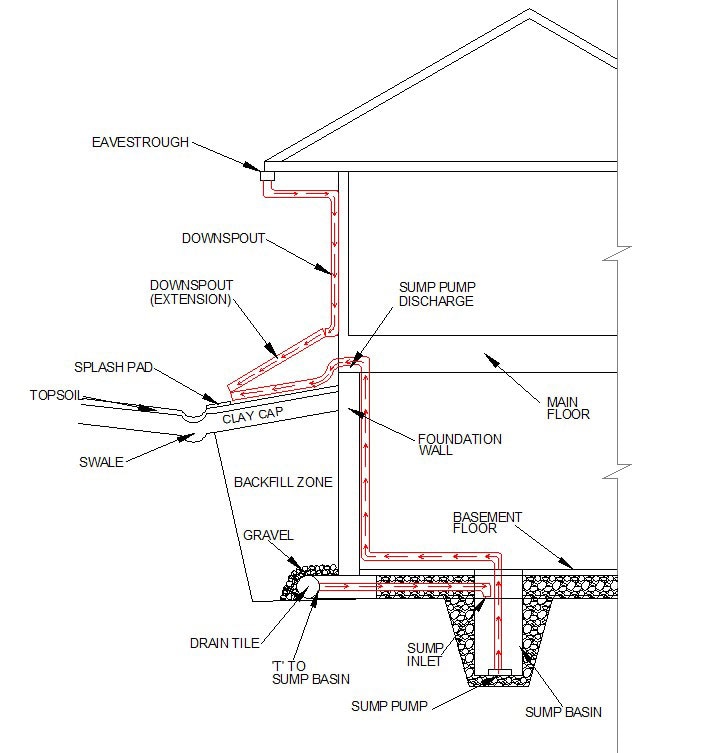Surface Water Management
Information for Homeowners
Managing surface water by directing water away from your home is the primary defense for keeping your basement dry and avoiding costly water damage. It is important to also consider where this water gets re-directed to. Your home has several systems that work in conjunction with each other to help control and manage all forms of irrigation, precipitation and groundwater.
Throughout the course of the year, Western Canada receives approximately 16 inches (400mm) of precipitation in the form of rain, snow, or hail. Coastal and mountain regions typically receive a greater amount of precipitation compared to other climatic regions. Therefore, it is critical to initially establish and maintain proper surface water management methods.
As part of the construction of your home, several systems have been installed that work to keep water out of your home. While your roof and exterior cladding form part of that system, there are several other components that many homeowners may not be familiar with.


Grade
- Residential builders are typically responsible for completing the rough grade requirements set out in the approved lot grade plan. This plan outlines and details the elevation variations of the property, as well as the surface water drainage patterns.
- Lot-to-lot drainage is typically not permitted, although the municipality may permit otherwise under certain circumstances.
- Surface drainage patterns should be reviewed annually. Depressions and areas of settlement should be filled as they occur. To limit water infiltration adjacent to the foundation, ensure that the clay cap material is maintained below the sod and topsoil.
- During the winter months, try to avoid shoveling excessive amounts of snow into any swales along your driveway and sidewalks. During the spring thaw, the accumulated snow may hinder the melting process and the ability of water to drain off the property. This increases the probability of water accumulating at the foundation.
Swales
- Part of the drainage pattern will involve swales. Swales are shallow depressions in the rough grade and are designed to direct surface water away from the home and towards a Municipality approved location such as the street or catch-basin.
- Swales are typically located along property lines between homes and generally follow the contours of the lot grading plan.
- It’s important to make sure that swales don’t direct water toward any backfilled areas (close to the foundation) or adjacent properties. Each lot must conform to the approved lot grading plan.
- Swales must be maintained to ensure surface water is moved away from the foundation of the home.
- Insufficient swale maintenance and/or alteration could result in excessive accumulation of surface water at the foundation which greatly increases the chance of water ingress into the basement.
- Grade and swale maintenance area homeowner’s responsibility.


Lot grading certificate
- The lot grading certificate verifies for the local jurisdiction that the correct lot grade designs and drainage patterns have been established. It is important to note not all Municipalities will require a lot grading certificate.
Window Wells
- Window wells are installed below grade level around a home to allow for the installation of windows.
- Window wells must be kept free of debris to ensure water can flow to the drain tile installed along the foundation footings.
- Window wells should be installed in accordance with the requirements of the local authority or Municipality and the Building Code in effect at the time of construction.
- It is a homeowner’s responsibility to ensure the window wells are kept clean.
Drain Tile
- Drain tile is perforated pipe installed below grade along the perimeter of the footings and is designed to control subsurface water.
- Depending on the soil conditions, water table and other considerations, some municipalities may not require the installation of a drain tile system.
- Drain tile is a secondary defense in the control of surface water.
- Drain tile helps reduce the pressure exerted by standing water against the foundation, directing it to a sump system for disposal via a surface discharge pipe or a storm sewer.
Sump System
- The sump system is comprised of a sump pump and collection basin in the basement, it removes accumulated water from beneath the basement floor and the drain tile system.
- Sump systems will either drain directly to the Municipality’s storm water system or will be pumped to the surface and discharged on the property via a discharge pipe. Some sump systems come with a hose attachment which allows for flexibility in the discharge location.
- If the sump pump runs continuously, ensure the discharge pipe (if draining to the surface) is clear of the backfilled area and that the grade is sloped away from the foundation, as water could be recirculating between the sump system and the surface grade therefore not being properly disposed of.
- A splash pad should be installed at the sump discharge location and should be sloped to direct water away from the foundation.
- During the winter months the sump discharge hose should be removed to ensure the hose does not freeze and crack. Discharged water should be directed onto a splash pad and away from the
foundation. - Routine inspection of the sump pump forms part of a homeowner’s maintenance program, however not all homes will include a sump system.
Eavestrough and Downspouts
- Eavestrough and downspouts are designed to collect and move bulk water from the roof and away from the foundation.
- Downspout extensions should be directed toward the designed swales or to the street or rear lane.
- Downspout extensions should not direct water onto an adjacent property.
- Downspout extensions should terminate past the backfilled area around the foundation.
- During the winter months, care should be taken when managing snow removal to avoid blocking water flow from the downspouts.
- Eavestroughs should be inspected and maintained on a regular basis to ensure proper operation and function. Debris can
build up and clog the eavestrough causing water to overflow and collect along the foundation. - As part of routine maintenance, it’s the homeowner’s responsibility to ensure the eavestroughs are kept free of debris.


Landscaping
- Landscaping is either completed by the builder or the homeowner after possession.
- Landscaping should maintain the drainage pattern established by the lot grading plan.
- Any alterations done by the homeowner should follow the intent of the original rough grade design.
- When completing the landscaping, keep in mind the rough grade design typically allows for a final grade depth of approximately four to six inches (10 to 15 cm) for the topsoil and sod combined.
Flowerbeds
- Some consideration must be given when choosing flowerbed locations.
- If you can help it, flowerbeds should not be placed immediately adjacent to the foundation as watering (in conjunction with precipitation) may saturate the surrounding soils and could potentially overload the foundation’s drainage system.
- If flowerbeds are placed immediately adjacent to the foundation, consideration should be given to the depth of topsoil and to the installation of plants that may require less frequent watering.
- Raised flower beds or mulch borders should not allow water to be retained against the foundation wall. Free drainage of water away from the foundation must be allowed.
- Topsoil cannot be used for control of surface water as it’s typically far too porous and tends to act as more of a sponge, holding the water in place.
- Prior to installing topsoil, a minimum one-foot (30 cm) clay cap should be utilized to ensure drainage away from the foundation.
Irrigation systems
- In-ground irrigation systems should be properly installed and maintained.
- Careful consideration should be taken with respect to the location of sprinkler heads.
- Sprinkler heads should not direct water toward the home.
- The use of rain sensors will help protect against over watering.
- Regular maintenance will ensure that there are no broken lines which could saturate the soils around the home.
- Prior to freeze-up, proper winterization of the irrigation system is important.
Ground settlement
- With new construction, areas of ground settlement are likely to occur. During construction, the excavation typically extends three to four feet (90cm to 120cm) past the edge of the foundationwall to ensure the builder can install the forms for the foundations and drain tile (if required).
- As the backfilled area around the foundation andutility lines cannot be compacted back to the original density as before construction began, water can easily collect in the backfilled area next to the foundation. As the water percolates through the backfilled soils, it consolidates the soils causing settlement.
- Homeowners can minimize the impact of soil settlement and water collecting against the foundation by ensuring that the clay cap material is maintained below the sod andtopsoil.